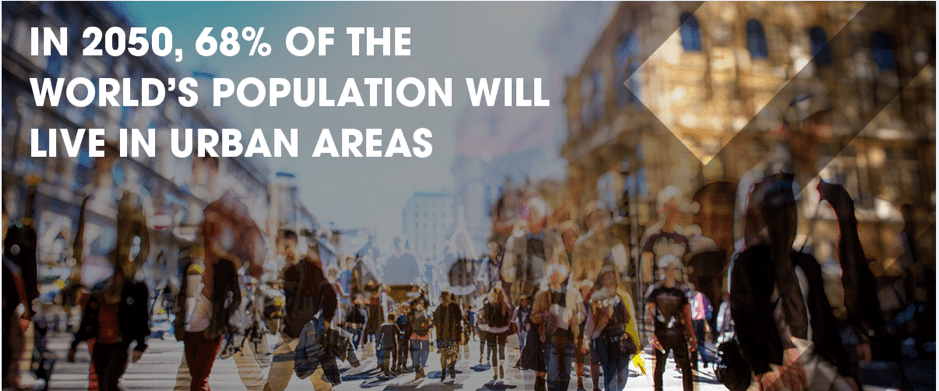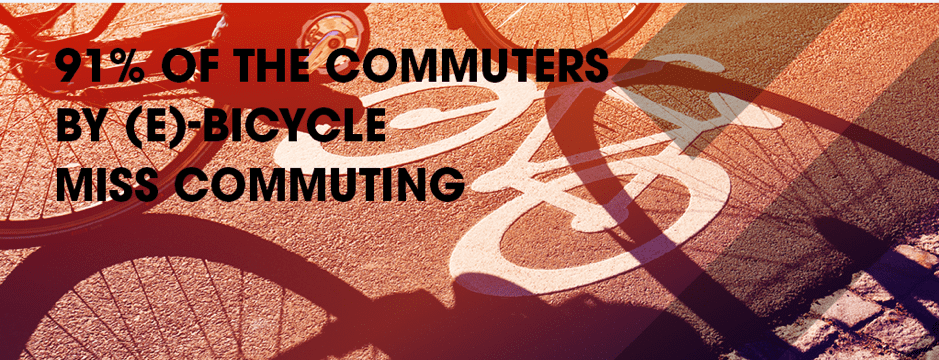Are we ready for Mobility as a Service?
Mobilty as a Service (MaaS), a hot topic in the mobility industry. Cities around the world are increasingly changing infrastructure, installing environmental zones and promoting multimodal transport. In order to get easy access to mobility, MaaS can offer a solution. What does MaaS entail and how can it speed up the mobility transition? Are we ready for it?
Urbanisation asks for new mobility
In 2018, around 55% of the world’s population was living in an urban area or city. It is estimated that this number will rise to 68% before 2050, according to the UN. Congestion costs the EU €100 billion annually. Urban mobility was responsible for 40% of the CO2 emissions. The developments in tackling congestion and emissions ask for sustainable solutions in the transport industry.

Electric & hybrid vehicles, e-bikes, e-scooters and shared mobility services have changed the traditional transportation landscape. The system is changing into a more demand-driven way of travelling from A to B. In this process, the focus has shifted from solely supplying transport itself, to additionally providing this service in the most effective and efficient way.
The advance of green transportation modes such as bicycles, e-bikes, e-scooters, electric vehicles, hybrid- trains and buses, contribute to designing a more sustainable economy together with a drop in air pollution. But how do we integrate all these new modes of transport within the traditional system into a real-time and on demand mobility service? What is the most seamless way to park your car on the outskirts of the city, connecting seamlessly to train and hire an e-bike for the last mile? The answer could be MaaS. Mobility as a Service could integrate all these sustainable transportation modes into one service for the perfect urban mobility.
On demand, seamless and user centric mobility
Mobility as a Service or MaaS entails one mobility service platform or application which makes it possible to provide various modes of transport services to the user on demand. Today we experience all kinds of applications for one or two modes of transport. However, MaaS could offer added value facilitating an integration of MaaS providers into one application offering real-time and on demand ride-, car-, or bike-sharing, public transport, and taxi or car-rental options to the user. Including payment and buying tickets. MaaS therefore covers all mobility segments: from public transport and infrastructure to traffic management and parking, all coming together in urban mobility. Putting the user first.

Customised smart mobility fits user’s changing lifestyle
MaaS has a lot to offer. First of all, the user centric service provides easy access to mobility, high-quality service and competitive pricing. Advanced data will help allocate resources efficiently based on a user’s wishes.
This customised smart mobility service pairs the diverse needs of the user for the changing daily lifestyle. Nowadays, millennials value physical car ownership less than in the past. In London, Brussels, Cologne and Amsterdam drivers used to spend more than 100 extra hours a year in traffic during rush hours. People care more about the environment. The Coronavirus could speed this all up. Today 55% of the car commuters do not miss their commute at all. 25% of the car commuters say they will work from home more often after lockdown. Whilst 91% of the (e)-bike commuters say they miss some aspect of their daily travel to work. Therefore, the prospect is that MaaS should be the best value proposition for transport services in the coming years.

By exploiting advanced data, not only can we improve traffic management; we can also improve our road safety. Data from Mobility as a Service platforms could help authorities manage and improve traffic flows. It is now that MaaS and the collection of data can flourish and really add value to both user and the road. According to IBM 90% of the data in the world in 2017 was generated within the last 2 years. This could speed up the transition from solely supplying transport to the user, to an integrated user centric smart mobility system by the use of big data.
Data as a revenue model make MaaS a profitable market for new transport services. Not only for new business. New innovations also offer co-operation and opportunities for traditional transport and infrastructure businesses. As mentioned before, next to the most important actor: the customer, MaaS involves several segments and actors within and outside the mobility sector all working together:
1. Transport operators
2. Data providers
3. Technical backend and IT providers
4. ICT infrastructure
5. Insurance companies
6. Regulatory organisations
7. Universities and research institutions
Sharing both knowledge and data poses challenges
Besides the pain point of including one payment system in the application, the success of Mobility as a Service lies in data and sharing knowledge. Combining strengths and knowledge for all modes of transport will improve seamless multimodal transport and therefore motivate the user. The more users, the more data is shared and thus the better the service can become. With this comes the biggest challenge authorities and developers of MaaS applications face. Sharing this amount of private data (including payments) with businesses leads to several challenges.
The core of the MaaS system is shared data. Sharing and processing consumer data comes with cyber security. Does the service own the data, or are you still in charge of your data? Another question often raised is whether the user data should be shared with emergency services and law enforcement. Currently, shared data has a high level of concern, and the impact of GDPR in Europe is commonly discussed. By implementing MaaS in a city, MaaS providers must develop a transparent system, in which the users are completely aware of how the practices take place and for what purpose their personal data is being used.

In the Netherlands the traditional fragmented nature of the transport industry slows down ‘the last mile’ in the development. Partnerships between public and private mobility operators are necessary to make MaaS work. Regulations and protocols for data sharing such as GDPR, is mainly initiated and done by governments. So how can we put MaaS in its full potential?
Like the Dutch programme manager of MaaS at the Ministry of Infrastructure & Water Management Eric Mink mentioned in a presentation last year: ‘We should not wait for, but develop alongside the market. So we developed an API together with around 30 Dutch vehicle sharing companies’ This has already been copied internationally and led to the next question: who is the client owner? MaaS or MaaS providers?
A new discussion arises. Recent report by Juniper Research showed MaaS platforms should be city led. While ridesharing giants such as Uber and Lyft are adding transit information to their applications; they are not neutral in the transport market. Therefore this model is expected to fail to engage the necessary transit partners for an effective solution. The research therefore recommends that MaaS vendors should focus on licensing platforms as neutral players.
MaaS, the first examples
Successful pilots have already been completed in Amsterdam, the Netherlands. One example was the project initiated in the Zuidas business district in Amsterdam where a select group of workers in the area were handed €1,000 to spend on their commute for the month. In order to make use of this great opportunity, they had to give up their company car for the duration of the project. The group was free to use their money as they wished, whatever was left of the money after the month, they could keep it to themselves. Part of a much broader smart mobility project, the intention was to ramp up the small-scale testing of MaaS-related services to something that can be of benefit to all Amsterdam citizens.
Helsinki is already a step ahead of Amsterdam. The capital city of Finland has an application available, which is owned by MaaS Global of Helsinki. By paying a monthly fee, the app, Whim, provides travelers with all modes of public and private transportation within the city. Trains, taxis, buses, car shares and bike shares are all included in the service. In 2017, Whim launched in Helsinki. In January 2019 they reached their first 3 million trips. The application is now expanding to several other cities such as, Singapore, Antwerp and Tokyo.
Another example of a MaaS platform is Mobilleo. Whereas the previous examples were focused on the consumer market, this MaaS platform focusses on B2B. Mobilleo is a Mobility as a Service technology platform which provides end to end journey discovery technology and services for all members at an office. The service offers different travel providers to create the best possibility to get from A to B in your business journey. Moreover, users can find, book and pay for their entire journey and have their travel documents safely stored within the application.
By 2027, MaaS will lead to a commuter time saving equal to 2.7 days per MaaS user per year. Which may feel like a system of your dreams, might be much closer to your reality. The benefits for both cities and the individual users are convincing. Cities will experience a solution to tackle congestion, and individuals will find the answer to their needs in only a few clicks on their smartphones. And finally, the technological resources necessary to realize Mobility as a Service, are already set in place: 4G and 5G networks, artificial intelligence, autonomous, electrical and shared vehicles. MaaS is ready to speed up the mobility transition. Are you?
Share your story
Do you have an innovation, research results or an other interesting topic you would like to share with the professionals in the infrastructure, traffic management, safety, smart mobility and parking industry? The Intertraffic website and social media channels are a great platform to showcase your stories!
Please contact our Sr Brand Marketing Manager Carola Jansen-Young.
Are you an Intertraffic exhibitor?
Make sure you add your latest press releases to your Company Profile in the Exhibitor Portal for free exposure.
Get up to speed on the mobility industry - our newsletter straight to your inbox!


.jpg?h=600&iar=0&w=1200)





